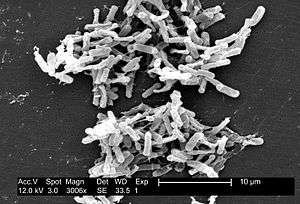Clostridioides
Clostridioides is a genus of Gram-positive bacteria, which includes Clostridioides difficile, a human pathogen causing an infectious diarrhea.
| Clostridioides | |
|---|---|
 | |
| SE micrograph of Clostridium difficile colonies from a stool sample | |
| Scientific classification | |
| Domain: | Bacteria |
| Phylum: | |
| Class: | |
| Order: | |
| Family: | |
| Genus: | Clostridioides Lawson and Rainey (2016) |
| Selected species | |
| |
Taxonomy
The genus Clostridioides was created to describe a few species formerly in the genus Clostridium which have been shown to be their own genetically distinct genus using 16S rRNA gene sequencing analysis.[1] However, both names are still in use and valid under the International Code of Nomenclature of Prokaryotes.[2]
Description
They are obligate anaerobes capable of producing endospores. The normal, reproducing cells of Clostridioides, called the vegetative form, are rod-shaped, which gives them their name, from the Greek κλωστήρ or spindle. Clostridioides endospores, like Clostridium endospores, have a distinct bowling pin or bottle shape, distinguishing them from other bacterial endospores, which are usually ovoid in shape.
References
- Lawson, Paul A.; Citron, Diane M.; Tyrrell, Kerin L.; Finegold, Sydney M. (August 2016). "Reclassification of Clostridium difficile as Clostridioides difficile (Hall and O'Toole 1935) Prévot 1938". Anaerobe. 40: 95–99. doi:10.1016/j.anaerobe.2016.06.008.
- Oren, Aharon; Rupnik, Maja (August 2018). "Clostridium difficile and Clostridioides difficile: Two validly published and correct names". Anaerobe. 52: 125–126. doi:10.1016/j.anaerobe.2018.07.005.